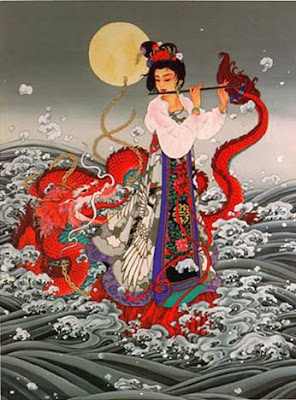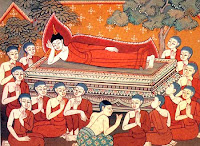
Pandaka literally means "eunuch." Generally, it is understood to be a transsexual or at the very least a transgender, often deviant, individual "lacking maleness." Homosexuality as understood today is not as it was understood in ancient India or even how it is understood today in various parts of Asia.
Leonard Zwilling

"It is evident, then, that we are dealing with a variety of sexual dysfunctions and variations categorized under the general rubric "
pandaka," and the reason for this is that they all share the common quality of being "
napumsaka," "lacking maleness." That is, for one reason or another they fail to meet the normative sex role expectations for an adult male.
"In the
Vinaya literature [the Monastic Disciplinary Code] references to
pandakas are made almost invariably within the context of sexual, specifically homosexual, behavior, and we find in many societies a tendency to label a boy or man who participates in homosexual activity as not being a "real man."[16]

"Even as early as the period of the
Atharva Veda, pandakas were viewed as a distinct group, different from ordinary males and females, and apparently transvestite. The
Vinaya, in fact, goes so far as to distinguish sexual activity between normative males from sexual relations between a socially normative male and a
pandaka.[17]
"The
pandaka was also viewed as possessing a distinct psychological makeup. According to
Buddhaghosa [by far the most famous ancient scholar in Theravada Buddhism]
pandakas are full of defiling passions (
ussanakilesa); their lusts are unquenchable (
avupasantaparilaha); and they are dominated by their libido (
parilahavegabhibhuta) and the desire for lovers just like prostitutes (
vesiya) and coarse young girls (
thulakumarika).[18]
"Thus the
pandaka is distinguished not by homosexual behavior per
se, but by the failure to fulfill male role expectations, was considered in some degree to share the behavior and psychological characteristics of the stereotypical "bad" woman.
"For
Vasubandhu, the psychological makeup of the
pandaka is such as to have significant ramifications for his ability to practice religion. On the one hand,
pandakas are incapable of religious discipline (
samvara) because to an inordinate degree they possess the defiling passions of both sexes...and they lack the sense of modesty and shame...necessary to counteract them.[19].
.

Buddhist monks pictured outside a nightspot on Patpong Road, Bangkok, an infamous commercial sex zone (Photo: AP; story: theage.com.au)."On the other hand, paradoxically, the
pandakas also... I can only speculate that this view of the
pandaka as lascivious, shameless,
unfilial, and vacillating is based on the social disabilities incurred by the
pandaka as a member of a stigmatized and
outcasted group, such as is formed by their present-day counterparts, the
hinjras,[22] as well as on the inability or unwillingness of such offspring to bring satisfaction to their parents either in this life by producing children or in the afterlife owing to their disqualification from funerary and after death rites.[23]
"
As for the etiology of the homosexual condition, Indian Buddhist tradition, at least as represented by
Buddhaghosa, agrees for the most part with traditional Indian medical thought in seeing it as being essentially an organic disorder, although one with an important psychological component.[24]
"
Buddhaghosa begins his analysis by pointing out that men and women obviously differ not only in what we call primary and secondary sexual characteristics, but in interests and inclinations as well....
"Also, a number of rules laid down in monastic law are meant to minimize the occasions for homosexual activity inevitable in closed, same-sex communities; for example it is forbidden for two novices to share the same
bedcover[35] and it is not allowed for two novices to serve one monk; this rule having been promulgated after it was discovered that two novices had each committed a sexual offense with the other.[36]
"
As to the ordination of the sexually nonconformist male, it will certainly be no surprise to find ordination denied to such individuals and that such denial has solid canonical authority.
As with all the rules in the system of Buddhist monastic law [
Vinaya], this regulation purportedly arose in response to a specific set of circumstances that in the
Pali tradition are recounted in the
Pandaka-vatthu section of the
Mahavagga.[37]
"The account is short enough, and of interest for the light it sheds on the perceived characteristics of
pandakas, that I give it here in its entirety:
"At that time a certain
pandaka was ordained among the monks. He approached a number of young monks and said: 'Come, Venerable Ones, defile me' (
etha, mam ayasmanto dusetha). The monks reproached him: 'Begone
pandaka, away with you! What have we to do with that?'
"Reproached by the monks he approached a number of large, stout novices. 'Come, Venerable Ones, defile me.' The novices reproached him: 'Begone
pandaka, away with you! What have we to do with that?'
"Reproached by the novices he approached the elephant keepers and the grooms and said: 'Come, Sirs, defile me.' The elephant keepers and grooms defiled him.
"They grumbled, became angry and irritated: 'These recluses, these followers of the Buddha
are pandakas and those who are not
pandakas defile
pandakas. Thus do they all lack discipline.'
"Monks heard those elephant keepers and grooms who grumbled, were angry, and irritated and those monks told this matter to
the Blessed One who said: 'Monks, if a pandaka is not ordained, let him not be ordained. If he is already ordained let him be expelled.'"[38]

A similar prohibition would appear to be extended to the sexually nonconformist woman as well. According to the
Cullavagga,[39] among the individuals to be denied ordination are the
animitta and the
itthipandaka. The latter, by analogy with the male
pandaka, would seem to be no more than the female of the species and the equivalent of the
narisanda, or
lesbian, of the medical literature.[40]...
"Beyond the prohibition against ordination,
Asanga, like
Vasubandhu, goes so far as to refuse the
pandaka recognition as a layman on the grounds that such persons are unfit to associate with or serve the
samgha [
Sangha] although, as a concession and perhaps reflecting a broader Mahayana perspective, he does allow them to practice the path of a layman if they so desire,[42] presumably without receiving recognition as a layman.
"Interestingly enough, the proto-Mahayana text Mahavastu recognizes that even such a highly advanced practitioner as a fourth stage bodhisattva may backslide owing to homosexual activity.[43]
"Although no explicit references to homosexuality are found in the Nikayas [the canonical divisions of the written Dharma], the collection of the Buddha's discourses in the Pali tradition, in the Puggalappasada-sutta of the Anguttara-nikaya[44] there is what may be construed as a warning to monks against homoerotic feelings.
"The Buddha warns that a monk who is devoted (abhippasanna) to another, who thinks: 'This person is dear and pleasing (priyo manapo) to me,' will be adversely affected if his friend is suspended or expelled by the Order, leaves, becomes mentally unbalanced, or dies.
"And again, Buddhaghosa, in commenting on a passage in the Cakkavatti-sutta of the Digha Nikaya,[45] describing the progressive degeneration in the life span of human beings following upon their increasing corporeality and sinfulness, takes the expression 'wrong conduct' (micchadhamma) as 'the sexual desire of men for men and women for women.'[46]
"In associating homosexuality with decline and decadence Buddhaghosa is undoubtedly reflecting a commonly held view of his time, a view also expressed in the great Indian epic, the Mahabharata.[47]
"In the sutra literature of Sanskrit Buddhism..."











































































































































































































































































